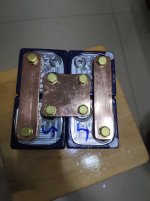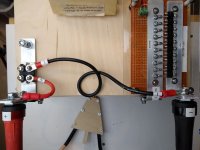Hi Guys,
I'm new here, but have found this particlar thread to be incredibly helpful in building a battery spot welder. I'll try to post some pictures soon.
Main welding power source is a 12V 710CCA car battery.
Used ten IRF3205 mosfets on a 1"x1/4" aluminium flat bar.
An Aduino Nano is at the heart of things.
Probes are about 40cm long 8awg stranded wire. The electrodes are made from some copper tube, with the 8awg soldered in one end, and some very short copper nail in the business end.
Flyback is (hopefully) being taken care of by two 30SQ045 schottky diodes from the drain back to the battery positive.
Also have five 1.5KE TVS diodes between source and drain. Not sure if these are needed or correct, but they don't seem to hurt

So a footswitch starts the process. A short pulse (10% of the main pulse is) is fired, followed by a 100ms delay, followed by the main welding pulse, which can be set between 1-40ms by a simple potentiometer. A TC4420 mosfet driver controls the gates (driven with a 12V supply). I have one ten ohm resistor on each gate.
Messed around a bit with the first pulse (between 10-20%). No really any noticeable difference. But definitely a diferent when i turned it off. So it's set at 0% now. Also the delay between the pulses didn't make any notecable difference, so just left it at 100ms. Not using the arduino timers to control it, just simple delayMicrosecond() and delay() functions. Accurate enough I think.
Welding a 0.15mm nickel strip to an 18650 is very consistent. Timing is 7ms. After about 50 repeated welds within a couple of seconds of each other the mosfets and the aluminium bar were up to around 40 degree C (ambient temp around 30 degrees). The 8awg wires were a little warm so will be changing them to 6awg as and when the wire arrives.
Over this weekend it has done over 1000 welds and all is still good, but I'm sure that there's room for improvement.
We back to back tested it against a couple of cheap ebay specials and there was no comparison. The ebay versions were all quite inconsistent with anything over 0.12mm nickel strip.
Next plan is to implement an 'auto' feature, but I hope that's pretty simple. I'm not a fan of the footswitch. Just lazy perhaps

Anyway, just thought that I'd share my experience seeing as I trawled this thread pretty heavily during making the welder.
Cheers,
Matt.



